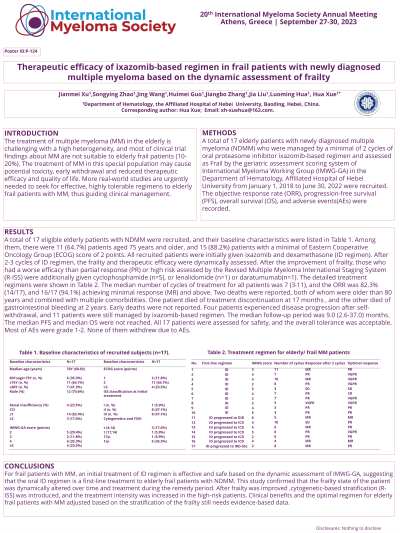Treatment of Newly Diagnosed Myeloma - Non-Transplant Eligible
Poster Session 1
P-124: Therapeutic efficacy of ixazomib-based regimen in frail patients with newly diagnosed multiple myeloma based on the dynamic assessment of frailty
Wednesday, September 27, 2023
1:30 PM - 2:30 PM EEST


HUA XUE, MD
Head of the department of hematology
Affiliated Hospital of Hebei University
baoding, Hebei, China (People's Republic)
Introduction: The treatment of multiple myeloma in the elderly is challenging with a high heterogeneity, and most of clinical trial findings about MM are not suitable to elderly frail patients (10-20%). More real-world studies are urgently needed to seek for effective, highly tolerable regimens to elderly frail patients with MM based on the dynamic assessment of frailty, thus guiding clinical management.To explore the efficacy and safety of the oral proteasome inhibitor ixazomib-based regimen in frail patients with newly diagnosed MM based on the dynamic assessment of frailty in the real world.
Methods: A total of 17 elderly patients (NDMM) who were managed by a minimal of 2 cycles of oral proteasome inhibitor ixazomib-based regimen and assessed as Frail by the geriatric assessment scoring system of IMWG-GA in Affiliated Hospital of Hebei University from January 1, 2018 to June 30, 2022 were recruited. The objective ORR, PFS, OS, and AEs were recorded.
Results: A total of 17 eligible elderly patients with NDMM were recruited, and their baseline characteristics were listed in Table 1. Among them, there were 11 (64.7%) patients aged 75 years and older, and 15 (88.2%) patients with a minimal of Eastern Cooperative Oncology Group (ECOG) score of 2 points. All recruited patients were initially given ixazomib and dexamethasone (ID regimen). After 2-3 cycles of ID regimen, the frailty and therapeutic efficacy were dynamically assessed. After the improvement of frailty, those who had a worse efficacy than partial response (PR) or high risk assessed by the Revised Multiple Myeloma International Staging System (R-ISS) were additionally given cyclophosphamide (n=5), or lenalidomide (n=1) or daratumumab(n=1). The detailed treatment regimens were shown in Table 2. The median number of cycles of treatment for all patients was 7 (3-11), and the median ORR was 82.3% (14/17), and 16/17 (94.1%) achieving minimal response (MR) and above. Two deaths were reported, both of whom were older than 80 years and combined with multiple comorbidities. One patient died of treatment discontinuation at 17 months , and the other died of gastrointestinal bleeding at 2 years. Early deaths were not reported. Four patients experienced disease progression after self-withdrawal, and 11 patients were still managed by ixazomib-based regimen. The median follow-up period was 9.0 (2.6-37.0) months. The median PFS and median OS were not reached. All 17 patients were assessed for safety, and the overall tolerance was acceptable. Most of AEs were grade 1-2. None of them withdrew due to AEs.
Conclusions: For frail patients with MM, an initial treatment of ID regimen is effective and safe based on the dynamic assessment of IMWG-GA, suggesting that the oral ID regimen is a first-line treatment to elderly frail patients with NDMM. Clinical benefits and the optimal regimen for elderly frail patients with MM adjusted based on the stratification of the frailty still needs evidence-based medical data.
Methods: A total of 17 elderly patients (NDMM) who were managed by a minimal of 2 cycles of oral proteasome inhibitor ixazomib-based regimen and assessed as Frail by the geriatric assessment scoring system of IMWG-GA in Affiliated Hospital of Hebei University from January 1, 2018 to June 30, 2022 were recruited. The objective ORR, PFS, OS, and AEs were recorded.
Results: A total of 17 eligible elderly patients with NDMM were recruited, and their baseline characteristics were listed in Table 1. Among them, there were 11 (64.7%) patients aged 75 years and older, and 15 (88.2%) patients with a minimal of Eastern Cooperative Oncology Group (ECOG) score of 2 points. All recruited patients were initially given ixazomib and dexamethasone (ID regimen). After 2-3 cycles of ID regimen, the frailty and therapeutic efficacy were dynamically assessed. After the improvement of frailty, those who had a worse efficacy than partial response (PR) or high risk assessed by the Revised Multiple Myeloma International Staging System (R-ISS) were additionally given cyclophosphamide (n=5), or lenalidomide (n=1) or daratumumab(n=1). The detailed treatment regimens were shown in Table 2. The median number of cycles of treatment for all patients was 7 (3-11), and the median ORR was 82.3% (14/17), and 16/17 (94.1%) achieving minimal response (MR) and above. Two deaths were reported, both of whom were older than 80 years and combined with multiple comorbidities. One patient died of treatment discontinuation at 17 months , and the other died of gastrointestinal bleeding at 2 years. Early deaths were not reported. Four patients experienced disease progression after self-withdrawal, and 11 patients were still managed by ixazomib-based regimen. The median follow-up period was 9.0 (2.6-37.0) months. The median PFS and median OS were not reached. All 17 patients were assessed for safety, and the overall tolerance was acceptable. Most of AEs were grade 1-2. None of them withdrew due to AEs.
Conclusions: For frail patients with MM, an initial treatment of ID regimen is effective and safe based on the dynamic assessment of IMWG-GA, suggesting that the oral ID regimen is a first-line treatment to elderly frail patients with NDMM. Clinical benefits and the optimal regimen for elderly frail patients with MM adjusted based on the stratification of the frailty still needs evidence-based medical data.
